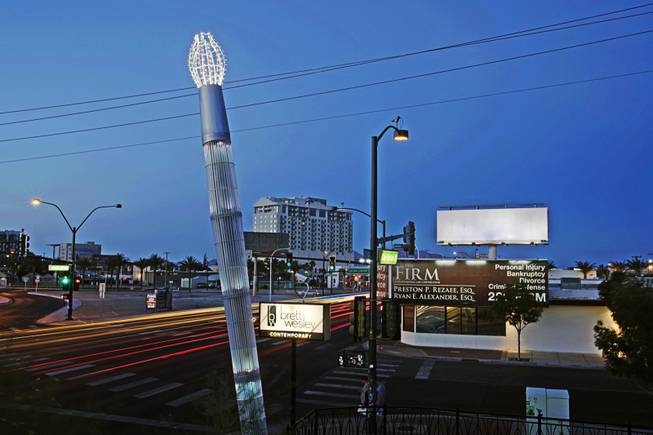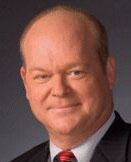
A view of one of the two Dennis Oppenheim paintbrushes on Charleston Boulevard in the Arts District Sunday, June 5, 2011.
Thursday, March 7, 2013 | 2 a.m.
For well over a decade, art has been part of the planned rebirth of downtown Las Vegas.
The First Friday art walk, begun with 100 or so people meeting at the Arts Factory on Charleston Boulevard, was one of the first steps toward integrating art with redevelopment.
More recently, the Emergency Arts building, a refurbished medical clinic whose examination rooms now house art galleries, was born on Fremont Street.
So it came as something of a shock to downtowners a few weeks ago when Las Vegas Councilman Bob Beers suggested eliminating the city’s Percent for the Arts program. Created in 2003, the program allows the city to collect “not less than 1 percent” of the city’s annual capital improvements budget for the arts fund.
Since collections began in 2005, the city has put $1.3 million into the fund, 96 percent of which came during the first three years. In the five years between 2008 and fiscal year 2012, the fund collected just $83,000.
Out of that fund, the city spent $1.1 million on art projects, leaving a balance of about $200,000 as of June 30, 2011.
Some of the projects funded with the money include the Arts District gateway, which has 45-foot-tall metal and colored light paint brushes visible on Charleston Boulevard at Casino Center Boulevard and Fourth Street; $350,000 went to that project.
Other projects and costs include the Centennial Hills Leisure Center, $89,777; Casino Center Streetscape, $278,238; Urban Pathways, $30,000; Time Capsule, $21,500; Doolittle Senior Center sculpture, $66,500; Cultural Corridor bridge, $50,000; and Southern Nevada Police Memorial Sculpture, $214,188.
The metallic paint brushes received the most of any project, and that irks downtown businessman George Harris because the artist, Dennis Oppenheim, was not local. Oppenheim, a New Yorker, died of cancer in 2011.
Harris is co-owner of Mundo restaurant and Beers is his chief financial officer. Harris said he was a big supporter of the arts. Indeed, Mundo is within the World Market Center complex and benefits greatly from the traffic generated by the nearby Smith Center for the Performing Arts.
The former Clark County GOP chairman who also ran for mayor in 2011 said his only trouble with the city’s art program was that the money doesn’t always stay in Las Vegas.
“I’m all for getting rid of the program if the money is going to go to out-of-state artists,” he said. “But I’m fine with keeping it if it is segmented for artists in Las Vegas.”
Downtown businesses, though, aren’t of one mind on this issue.
The Downtown Las Vegas Alliance, which represents downtown businesses, is taking a more circumspect view of Beers’ idea.
“There’s no doubt that when artists are attracted to a community, the community is uplifted,” said Terry Murphy, alliance president. “But local government has extraordinary demands on its resources. Having a discussion about prioritizing resources is always a responsible course of action.”
Local artist Ginger Bruner is less charitable in assessing Beers’ proposal, which he announced Feb. 20 at the City Council’s meeting. Bruner is co-founder of “Our Las Vegas,” which has received about $20,000 in funding from the city Arts Commission over 2 1/2 years.
She ran into Beers downtown Tuesday afternoon, engaging in a friendly debate at the Beat coffee shop.
“I think (Beers) is just doing this for political gain,” Bruner said. “Either that or he’s a shortsighted person with no sense of style.”
Beers said political gain had nothing to do with his proposal.
“This is not a publicity stunt at all,” he said. “It’s a common-sense approach to live with a set of legislative directives forcing us to spend more money every year to get the same level of service while revenue is falling.”
A third-generation Las Vegan, Bruner believes downtown’s revival would not be happening without art. And the art came first.
“Before First Friday, there was the Arts Factory and then there was the long struggle to try to get the Contemporary Arts Collective to move from near UNLV to downtown,” she said.
“Everybody wants to cut the arts first, but the amount is so minuscule, why that needs to be cut is beyond me.”
Joe Schoenmann doesn’t just cover downtown, he lives and works there. Schoenmann is Greenspun Media Group’s embedded downtown journalist, working from an office in the Emergency Arts building.


Join the Discussion:
Check this out for a full explanation of our conversion to the LiveFyre commenting system and instructions on how to sign up for an account.
Full comments policy